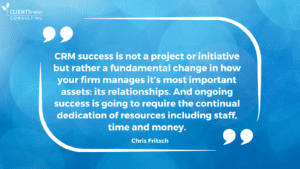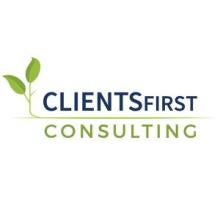A successful CRM implementation is not necessarily easy. But not everyone gets that. In fact, sometimes it seems that organizations think you can just buy a CRM system, plug it in and turn it on and clients will line up at the office door with bags of money.
In fact, compared to other technology deployments, CRM implementations can require more effort because you have to get users to actually use the system (ok, I’m a glass-half-full kind of person so just let me dream). And although the ultimate goal of CRM is to make things easier, some initial work is required.
In addition, failed CRM investments (and there are a LOT of them) are often expensive and frustrating. But by prioritizing and following some simple steps, real returns can be gained on CRM investments.
If you are having challenges deploying a new CRM or getting more value from an existing implementation, here are six steps you can take to turn your CRM project into a CRM success story.
1. Analyze Firm needs and Expectations
Success starts with a strong understanding of your organization’s needs and requirements. Before buying CRM software, it is imperative to thoroughly assess your needs and the reasons for acquiring the technology. You can start by asking some fundamental questions such as:
-
What problems are we trying to solve?
-
What processes are we trying to automate?
-
What are we trying to accomplish?
-
Who will use the software?
-
How will we get them to use it?
2. Know your audience
Once you have identified your core constituencies, it is important to ask for their opinions and gain their buy-in. You can start by scheduling meetings with the key stakeholders whose input and participation is critical to project success.
Rather than having broad, long conversations about technology that will not necessarily engage your stakeholders, focus on how the system will benefit them, including solving problems, increasing efficiency, fostering coordination, or identifying opportunities and improving business development. For leadership, focus on things they care about most such as reducing costs, enhancing coordination and improving profitability.
3. Dedicate Resources

CRM success is not a project or initiative but rather a fundamental change in how your firm manages it’s most important assets: its relationships. And ongoing success is going to require the continual dedication of resources including staff, time and money.
Implementation costs are often underestimated so be sure to consider not just the software but also the professional services to install it, the integration and data migration and ongoing maintenance. Also, don’t forget internal costs for system management and administration as well as ongoing communication and training. Most importantly don’t forget about the data.
4. Maintain Data Quality
The last thing you want to do is put dirty data into a clean CRM system because if the data is bad, then the professionals or other users won’t trust or adopt the system.
Before migrating your existing contacts, lists or CRM data, be sure to do a data quality assessment. This will help you to assess and address the ‘mess’ and scope the costs of your data quality project. Be sure to start early because the data cleanup can sometimes take quite a while depending on the number of contacts and lists you have.
Next come up with a plan for data cleanup. Automated data cleaning can be a great first step to tackle the initial issues. Later data quality professionals, also known as data stewards, which you can outsource, can be deployed to get the data as close as possible to its ideal state.
Bad data can cause serious issues during any stage of a CRM project, so devote ongoing resources. Also, to enhance data cleanup efforts and prevent bad data from causing problems in the future, it’s important to establish documentation for your organizations data quality styles and standards and outline the organization’s specific data processes to ensure consistent contact data entry, formatting and updating.
5. Communicate Effectively
Effective communications is essential for CRM adoption, and ultimately CRM success. To encourage your busy professionals to use the system, you must show them how the system will provide value not only for the organization but for them individually. Your communication efforts should focus on how the system is going to make their work lives easier. Depending on the size of your organization and how many users you have, it may be beneficial to plan a formal communications strategy and campaign to set expectations, garner excitement and promote success.
6. Continuous Training
Your CRM investment will not be fully realized unless the system is used regularly and consistently. This means that individual, user-focused training is critical. CRM training must be focused on the why, not the how, of CRM, and should be tailored to the business-specific processes used by your professionals. Focus on their perspective and why they would want to use it and emphasize what is in it for them. CRM training plans, processes and timelines should also be created, and metrics should be defined for measuring success. This allows you to easily communicate the benefits and value the system can provide.




 />i
/>i

